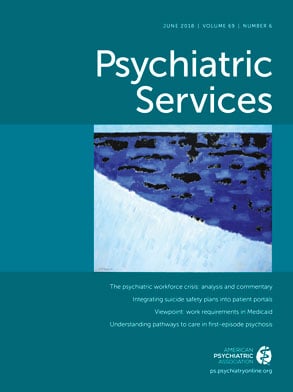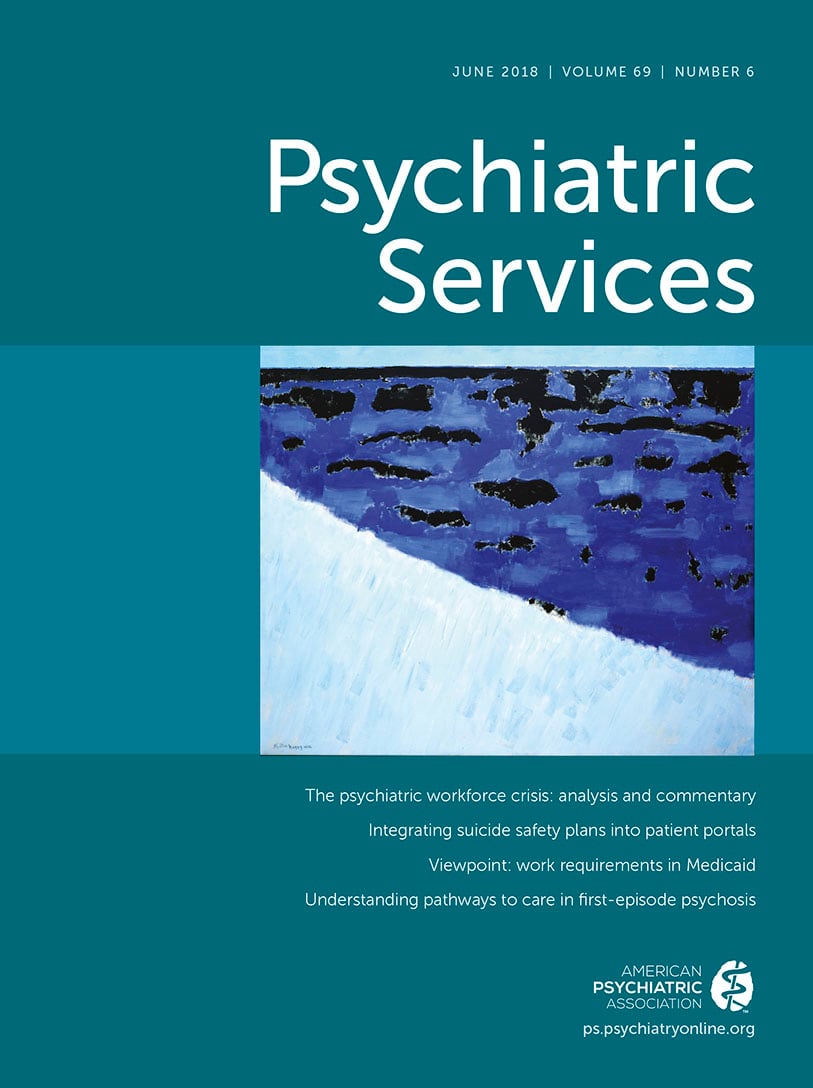Roughly 12% of all visits to the emergency department by Medicaid enrollees are related to behavioral health conditions, including addiction (
1). Medicaid enrollees are at especially high risk of using the emergency department for addiction-related conditions, given that they are 40% more likely than the general population to have an addiction and are substantially more likely than other Americans to use the emergency department overall (
2–
4). In 2010, alcohol and drug use were among the top ten reasons for hospital readmissions among Medicaid enrollees (
4). Because emergency services are among the most expensive forms of medical care, high use has significant cost implications. Addiction to alcohol and other substances ranks fifth and tenth, respectively, among high-cost diagnoses among Medicaid enrollees. Given that Medicaid spends $5 billion annually on addiction treatment (
5), preventing unnecessary use of emergency services is important, not only to improve patient outcomes and well-being but also to maximize use of resources.
Although reasons for high rates of emergency department use for addiction among Medicaid enrollees are complex, evidence suggests that poor access to outpatient addiction treatment plays a role. When addiction goes untreated, its severity may escalate and may result in conditions that require emergency services, such as overdose and withdrawal (
6,
7). However, fewer than one-third of Medicaid enrollees with addiction ever receive any treatment for their condition (
8). Among enrollees who sought addiction treatment and did not receive it, lack of treatment availability was identified as a principal barrier (
9). Accessing treatment can be especially challenging for Medicaid enrollees, compared with other insured groups; low rates of participation in Medicaid by treatment programs have plagued the Medicaid program for years (
10). Just under half of outpatient addiction treatment programs do not serve Medicaid enrollees, and more than 40% of U.S. counties lack a single outpatient addiction treatment program that accepts Medicaid (
8).
In South Carolina, all counties have at least one treatment program that accepts Medicaid. However, many counties have only a single program that does so. Moreover, the state devotes significantly less funding to provide free and low-cost addiction treatment to those who are uninsured or unable to find a treatment program that accepts their insurance. In 2013—the most recent year for which data are available—South Carolina spent $1.35 per capita on addiction treatment services, a rate significantly lower than the national average of $9.69 per capita (
11). The challenge is compounded by the fact that South Carolina has a higher proportion of low-income residents than most states, ranking tenth among states with the highest rates of poverty nationally.
It remains unclear how access to outpatient addiction treatment programs among Medicaid enrollees is related to use of emergency services for addiction-related conditions. Prior research has demonstrated that patients with untreated addiction are more likely than other patients to use emergency services and more likely to have repeat visits of emergency service use related to addiction (
6,
7). Furthermore, evidence suggests that regular access to outpatient treatment may reduce repeat use of emergency services after an addiction-related emergency service visit. For example, a study by Laine and colleagues (
12) found that use of outpatient addiction treatment significantly reduced the likelihood of hospitalization related to alcohol but not to other drugs among Medicaid enrollees in New York. A more recent study by Schwarz and colleagues (
13) found that access to opioid treatment medication in outpatient settings significantly reduced use of emergency services. Our study built on these findings by assessing the role of geographic availability of outpatient addiction treatment on repeat addiction-related use of emergency services in a state population of Medicaid enrollees.
Methods
We examined whether the availability of outpatient addiction treatment programs that accept Medicaid in South Carolina’s 46 counties was associated with repeat use of the emergency department for the treatment of addiction-related conditions. Study data were for all adult (ages 18 and older) Medicaid enrollees (N=2,401) with at least one addiction-related treatment visit in an emergency department in any of South Carolina’s 73 hospitals from January 1, 2012, to December 31, 2013. Hospitals reported visit data to South Carolina’s health data administrative reporting system. The study was approved by the University of South Carolina Institutional Review Board.
The dependent variable was a dichotomous measure assessing whether an individual had repeat (two or more) addiction-related treatment visits in the emergency department. Unique patient identifiers permitted tracking of multiple visits for a single Medicaid enrollee over time and across hospitals. Addiction-related visits were those with primary ICD-9 codes for alcohol and drug use, dependence, and withdrawal identified in a subset of all treatment visits with a major diagnostic code of 20.x. The independent variable, drawn from the 2012 National Survey of Substance Abuse Treatment Services, measured the number of outpatient addiction treatment programs that accepted Medicaid in each county. Given the relatively narrow range of programs accepting Medicaid (one to three programs per county), we created a dichotomous variable indicating whether one treatment program or two or more treatment programs in the county accepted Medicaid enrollees.
We developed a multilevel regression model to assess variables at both the individual and county level. Enrollee-level variables included age, gender, race-ethnicity, primary substance of abuse at admission for the majority of enrollee visits (alcohol, opioid, or other [cocaine, methamphetamine, marijuana, and nonspecific]), and geographic region (rural or nonrural). We created two dichotomous variables to assess whether enrollees received a secondary diagnosis of a psychiatric disorder (depression, anxiety, or psychosis) or a chronic general medical condition associated with high rates of emergency department use (asthma, diabetes, coronary artery disease, stroke, or chronic kidney disease) during at least one addiction-related emergency department visit (
14). County-level variables included total number of Medicaid enrollees, total number of outpatient addiction treatment programs in the county (including those that do not accept Medicaid), and a dichotomous measure indicating whether at least one outpatient treatment program in the county offered opioid treatment medication for addiction, such as methadone, buprenorphine, or naltrexone.
Descriptive statistics were calculated for all study variables. We used random-effects logistic regression, accounting for within-county effects, to assess the association of residing in a county with two or more outpatient addiction treatment programs that accept Medicaid with the odds of having a repeat addiction-related emergency service visit. Our model assumed the following form:
where P(Γ
ij=1x
ij,U
0j) is the probability of any repeat visit (Γ) during the study period, given a vector of patient-level explanatory variables (x) and a vector of county-level explanatory variables (U), and where γ represents the model coefficients. The i represents each visit, the j represents county, and x
ij is the value of an independent variable for visit i for a patient living in county j. Patient, treatment, and county control variables were included in the regression model to account for individual- and county-level differences. Results are reported as odds ratios (ORs). All analyses were conducted using Stata SE 14.1.
Results
Medicaid enrollees in this study had a total of 6,447 addiction-related emergency service visits during the study period, with an average of 1.8 visits per enrollee. Just over 30% (N=1,964) of all visits were repeat addiction-related visits. Most of the Medicaid enrollees in our study who had at least one addiction-related emergency service visit were white (N=4,133, 64%), and male (N=4,495, 70%). [A table in the online supplement presents data on enrollee- and county-level variables.] Alcohol was the most common substance of abuse reported (N=2,946, 46%). Almost half of all enrollees (N=3,147, 49%) resided in a predominantly rural county. There was an average of about four addiction treatment programs (including programs that do not accept Medicaid) in the counties in which enrollees lived, and approximately 60% offered at least some form of opioid treatment medication. Every county in which enrollees lived had at least one outpatient addiction treatment program that accepted Medicaid (including programs that offer opioid treatment medication and those that do not). Just over half (N=3,331, 52%) of South Carolina counties where enrollees resided had two or more programs accepting Medicaid.
Results of the logistic regression model indicated that the total number of addiction treatment programs that accept Medicaid in enrollees’ county of residence was inversely related to incidence of addiction-related emergency service visits (
Table 1). Enrollees who lived in counties with two or more programs that accept Medicaid were less likely to have repeat addiction-related emergency service visits (OR=.75, SE=.91). Age was also a significant predictor of repeat emergency service visits, with older enrollees at increased risk of repeat use of the emergency department for addiction-related conditions.
Discussion and Conclusions
In this study, the odds of repeat addiction-related emergency service visits were substantially lower among Medicaid enrollees who lived in counties with two or more outpatient addiction treatment programs that accept Medicaid. This finding suggests that geographic availability of treatment may play an important role in reducing the need for emergency care among Medicaid enrollees with addiction. It stands to reason that in places where addiction treatment is more plentiful, people who need it will be more likely to use it. In turn, use of regular outpatient addiction treatment may reduce the need for emergency services. Moreover, hospitals providing emergency services in counties with a greater number of local outpatient addiction treatment programs to which they can refer at discharge may be more successful in preventing repeat visits. However, further research is needed to test the validity of these possible explanations and explore causal mechanisms underlying the relationship between availability of addiction treatment, receipt of treatment, and subsequent use of emergency services.
The high incidence of addiction-related emergency services—roughly 2.5 visits per every 100 enrollees—suggests the need for targeted strategies to increase access to outpatient addiction treatment. Ideally, improving geographic availability and overall treatment access could reduce the number of Medicaid enrollees in crisis who require emergency services. Rural residents were heavily overrepresented among enrollees receiving addiction-related emergency services. Although rural residents made up only 35% of South Carolina’s Medicaid population in 2013 (
15), they represented just under half (49%) of enrollees with an addiction-related emergency service visit in our study. Rural counties may be particularly critical areas for intervention. Providing better access to local outpatient addiction treatment for Medicaid enrollees in rural communities could improve access to treatment and subsequently reduce the use of emergency services for addiction.
Several study limitations should be noted. First, our study included only data for individuals who received addiction-related treatment in the emergency department. We did not have data for enrollees who did not have an addiction-related emergency service visit. Second, our study was unable to account for whether treatment programs were accepting new patients. It is possible that some treatment programs had limited capacity and a waiting list for treatment. As a consequence, a treatment program could reportedly accept Medicaid enrollees but may not have actually done so during the study period. Third, our findings are generalizable only to South Carolina. Finally, data on the number of outpatient treatment programs that accept Medicaid were available only from 2012; the 2013 data have not been made publicly available. Although estimates of the proportion of addiction treatment programs in South Carolina accepting Medicaid showed very little change from 2012 to 2013 (59.8% in 2012 and 60.4% in 2013), we note the lack of availability of county-level data from 2013 as a limitation in this study.
Despite these limitations, this study provides new evidence of a link between availability of addiction treatment for Medicaid enrollees and reduced odds of repeated use of the emergency department for addiction-related problems.


